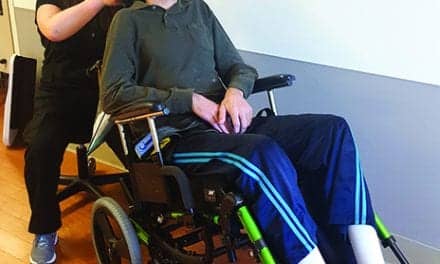A therapy technique combining targeted plasticity therapy—which involves stimulation of the vagus nerve—with traditional motor-skill rehabilitation doubles the rate of upper limb recovery in stroke patients, researchers suggest.
The study, by researchers from the University of Texas at Dallas, was published recently in Stroke.
The findings suggest that the therapy is not only safe, but is also twice as effective as rehab alone, according to a media release from the University of Texas at Dallas.
Dr Jane Wigginton, the chief medical officer at UT Dallas’ Texas Biomedical Device Center (TxBDC) and an associate professor of emergency medicine at UT Southwestern Medical Center, led the Dallas site of the clinical trial, which involved 17 people across the country who had suffered a stroke.
“Stroke is too common and too debilitating for us to tolerate the status quo,” Wigginton says. “Patients need a real solution so they can get back to fully living their lives.”
Dr Michael Kilgard, associate director and chief science officer of the TxBDC, invented targeted plasticity therapy (TPT). Kilgard, who is also the Margaret Fonde Jonsson Professor in the School of Behavioral and Brain Sciences (BBS), says the study results further validate the theories that he and his colleagues based their TPT work on beginning in 2009.
“We set out to design an approach that could transform long-term care and restore quality of life to patients for whom that has thus far been impossible,” adds Kilgard, who was not involved in the clinical trial, in the release. “These results show our method has immense potential. We’re excited about what this could mean for millions of stroke patients worldwide.
Researchers affiliated with the TxBDC and BBS developed the therapy technique, which pairs physical movements with precisely timed vagus nerve stimulation (VNS)—electrical stimulus of the nerve via a device implanted on the nerve in the neck.
After a stroke occurs, limb mobility can be affected when nerve cells are damaged. Such forms of brain trauma are often treated with rehabilitation that includes repeated movement of the affected limb in an effort to regain motor skills. The approach is thought to work by helping the brain reorganize.
Several studies of Kilgard’s technique in animal models have previously demonstrated that it is effective in recovering limb function after stroke. A small clinical trial in Europe also provided encouraging data for its potential use in humans.
In 2009, UT Dallas licensed its VNS technique as a stroke and tinnitus treatment to MicroTransponder, which sponsored the new double-blind, placebo-controlled study. Neither the researchers nor the study subjects knew who was getting VNS stimulation and who was not, the release continues.
Each study subject was a stroke patient whose stroke occurred between 4 months and 5 years prior to selection. After they had a VNS device implanted, the subjects received 6 weeks of in-clinic rehab followed by a home exercise program. About half were treated with active VNS while the rest received control VNS. All were assessed one, 30, and 90 days after therapy with a widely used, stroke-specific measure of performance impairment, the release continues.
In addition to showing that the technique is safe, the researchers found that subjects receiving active VNS scored more than twice as high as control subjects at the 30- and 90-day intervals, opening the way for larger, more extensive clinical trials, according to Kilgard, in the release. One such trial is in the recruitment phase and includes a study site in Dallas.
[Source(s): University of Texas at Dallas, Science Daily]




